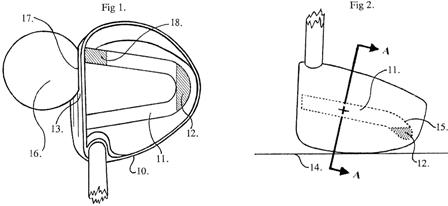Would it Work? Driver Head with “Flowing Moving Part”
Building on my prior post’s “Would it Work” topic, today we take a look at another common theme of golf club patents, specifically the topic of liquids within club heads. As I mentioned, the “Would it Work” category is directed to golf inventions that are likely to make at least half the readers say “come on, that would not work.”
Check it out!

The patent goes on to explain:
This invention reveals a golf club that has built into it’s head, a movable material that in play moves to cause the center of gravity to shift. The material referred to can be a fluid, such as mercury or it could be small metal spheres. All further references to “mercury” shall also be taken to mean `small metal spheres`. The mercury will be confined to a relatively small area in a modified “U” shaped passage contained inside the head and be constrained by centrifugal force during the downward swing of the club that takes place just before the golf ball is struck in the course of play to an area usually positioned at the lowest part of the passage and well back toward the rear of the head. Upon impacting a golf ball and the subsequent slowing of the head’s fixed parts, the mercury continues to move forward at or close to the speed of the club at impact. The position impacted on the face of the club will dictate whether the mercury divides, as would be the case with a center hit ball, or if a ball is struck well off center, all or the greater part of the mercury will be driven by kinetic energy into that sector of the passage leading to the struck area and with areas struck between these two positions causing the mercury to divide in proportions that match the impact point.
The present invention thus provides a golf club namely a driver, having a driver head, the head having a toe and a heel at opposite ends of a ball striking face for application of an impact force to a golf ball and a sole on the underside thereof, a shaft extending from the head, a surface within the head on the rear side of the ball striking face for application of a secondary impact force to a golf ball, a hollow passage within the head, the passage having first and second ends terminating at the rear surface at first and second positions on opposite sides of a central impact zone on the ball striking face, the hollow passage being arranged such that when the sole is supported on level ground with the ball striking face substantially upright, the hollow passage is inclined from the first and second positions downwardly and rearwardly from the rear surface of the ball striking face, and a liquid or flowable solid partly filling the passage, whereby upon downswing of the golf club, the liquid or flowable solid under the influence of centrifugal force will locate in a region of the passage intermediate the ends thereof and spaced from the rear surface and wherein the liquid or flowable solid will divide for application of a secondary impact force to the rear surface at the first and second positions where a golf ball is impacted by the ball striking face at or adjacent the central impact zone and wherein the liquid or flowable solid or the majority thereof will be directed for application of a secondary impact force on the rear surface at the first or second position depending upon which position is adjacent the point of impact of the ball striking face upon a golf ball.
So, “would it work?” My guestimate…. unlikely to have any influence on the ball flight.
Dave Dawsey – The Golf Patent Attorney
PS – Follow me on Twitter (@GolfPatents) to receive the latest golf patent updates
PPS – Click HERE to read about PING’s “Dynamically Variable MOI” Driver
